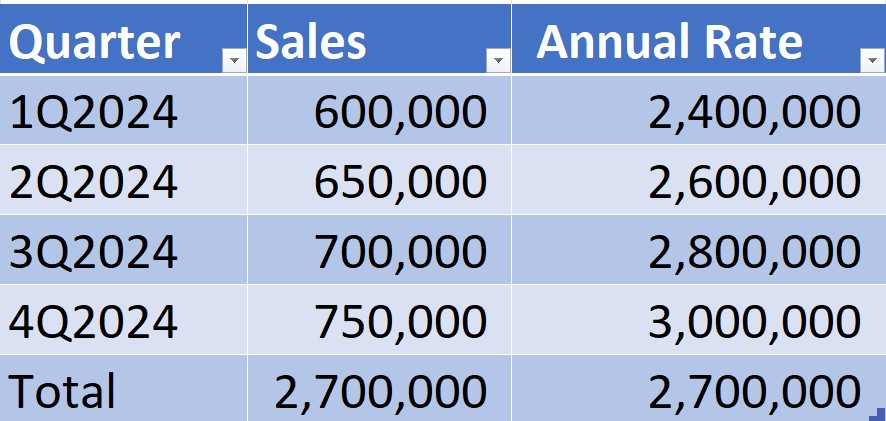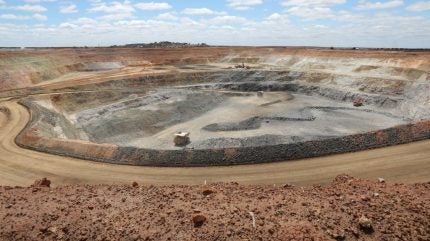
I like to think of problems like an economist. I studied economics in college and taught economics at community college many years ago. In order for Tesla to increase its sales 50% next year (I realize that is a long-term goal and every year doesn’t have to be exactly 50%), it needs to both increase demand for its vehicles and build them. Assuming Tesla builds and sells 1.8 million cars in 2023, a 50% increase would be to 2.7 million in 2024. But it is unlikely that Tesla would sell vehicles at a rate of 2.7 million for the whole year of 2024 — it would need to ramp up throughout as shown below.
So, given that math, how could they do it? I’ll look at supply and demand. You can’t sell what you can’t build. Although there is plenty of demand for a $25,000 compact car that can drive itself (Level 5 autonomy), it is unlikely Tesla can build that next year.
Supply
20 months ago, below is how Troy Teslike thought Tesla could produce 2.7 million vehicles in 2024, and I think that is still pretty accurate. I’ll ignore the Roadster and Semi, since the volumes are insignificant and the Cybertruck has obviously been delayed a year or so, too.
Here is what I think Tesla’s production will be with the current buildings. There will be new buildings in 2024 and 2025. Those are not included here.
However, apparently, it’s already too late to add capacity to Berlin for 2024 because trees can’t be cut between March and Sep. pic.twitter.com/dcO4FSPXmI
— Troy Teslike (@TroyTeslike) January 24, 2022
Below is a recent post from Troy, and we can see Model Y production at over 170,000 a quarter in Shanghai is much higher than the estimate of 115,125 from 20 months before. Likewise, the peak production of 67,548 of Model Y is much higher than the 32,000 predicted. However, this is likely because the Texas and Berlin rates of production are far below his (and my) earlier expectations.
Hi everybody. My Tesla production estimate for Q3 was 422,243 on 29 Aug. That’s a 12% drop vs. 479,700 in Q2.
This is related to factory upgrades. Elon talked about this. You can listen here: https://t.co/rky2nU9ozw Deliveries will be less affected because of existing inventory. pic.twitter.com/G1nXI2Ykl6
— Troy Teslike (@TroyTeslike) September 6, 2023
- Fremont can likely expand production to about 700,000, primarily converting the Model 3 to use Gigacastings for the front and rear. This might be part of the Highland refresh or it might be on a different schedule, but it is important in order to increase the production of the Model 3 to meet the slightly increased demand expected because of the refresh.
- Shanghai is currently at almost a million annual run rate, and I expect it to be able to produce 1.2 million cars next year with the production upgrades it has made and has planned for year.
- Berlin’s ramp has been a bit disappointing, but I expect the factory can produce 400,000 Model Ys next year.
- Austin’s ramp of the Model Y has likely been slowed by the slower-than-expected ramp of 4680 batteries, but I expect that to improve next year and Tesla to be able to increase Model Y production to 300,000 units and Cybertruck production to be around 100,000 units.
- It’s possible Tesla could make a handful of its next-generation compact cars now that it doesn’t have to build a new factory, but I think it is unlikely to produce enough to make a difference in 2024.
This adds up to the 2.7 million cars we need next year. Now let’s look at the equally (or possibly more) challenging issue of generating that much demand with only 3 mainstream models.
Demand Levers
We need sufficient demand levers to sell an additional 900,000 vehicles worldwide.
- Full Self Driving isn’t likely to improve to allow Level 5 autonomy in 2024. As a great driver-assistance system at Level 2, I expect it could generate an additional 100,000 units of demand, and that is being optimistic. I think this will generate almost unlimited demand once it is able to be approved for Level 5, but that will take years and not help much with 2024 demand.
- Cybertruck demand will exceed supply unless it is priced too high. I don’t expect it to be priced so high as to blunt demand, so I expect Tesla will have no problem selling 100,000 units if it can build them. The large backlog doesn’t mean a lot, since many people ordered and won’t buy unless the product is a good value.
- A lower-priced rear-wheel-drive Model Y (as is available in much of the world) that is available in the US around $42,000, or about $35,000 after the Federal Tax Credit, would greatly expand sales of the car — by about 100,000 units, I estimate — which is a huge increase in a single country, especially since it is already the best selling car in the world.
- The refreshed Model 3 could increase demand worldwide from about 500,000 units to 600,000 units, a 100,000 increase.
- A refreshed Model Y could increase demand by about a 100,000 or more if it is available by next summer.
- In 2024, the US Federal Tax Credit becomes a point-of-sale credit, which means the buyer gets it at the same time they buy the vehicle. Hopefully, Tesla vehicles will be able to claim the full credit at the time of sale and get the full $7,500 credit, but both of those are unknown at this time. If buyers are able to claim the credit at the time of sale in the US, this should increase demand by 100,000.
- Tesla has spoken about increasing leasing in selected markets. In the US, you can use this to get the full $7,500 tax credit in situations where the buyer isn’t eligible or the car isn’t eligible. Tesla would prefer not to use its capital this way, but may need to depending on how things go. It is likely Tesla could increase sales by 50,000 or more if it greatly expanded leasing with aggressive terms. If it allowed owners to buy the car at the end of the lease, it could expand sales even more.
- Tesla either decides to sell new entry-level Model 3 and Y with downgraded features like cloth seats, a less impressive stereo, smaller wheels, etc. This would allow prices up to $5,000 lower, but might hurt the brand’s image. The company might prefer to just sell its existing models for a lower price and sacrifice margins and profits to continue to expand sales. Lowering the price of the Model 3 and Model Y up to $5,000 should generate at least 200,000 additional global sales.
- As I discussed in this article, advertising is needed to educate consumers about the many advantages of electric vehicles, to counter negative myths (FUD), and to inform people how affordable Tesla vehicles are. Depending on the level of advertising, Tesla could generate additional demand for 200,000 or more vehicles.
This adds up to 950,000 units, but these estimates are approximate and there are of course many other factors — like interest rates, economic recessions, and the “competition” — that will affect demand both positively and negatively.
Conclusion
This isn’t intended to address all the factors that will affect Tesla sales next year, but to comment on the major items that will affect it that are specific to Tesla. Tesla has shown an incredible ability to meet its goals in the face of many difficulties, such as supply chain disruptions, financial pressure, negative press coverage, manufacturing difficulties, and more. I don’t know if Tesla will sell 2.7 million vehicles next year, but I know it will expend extreme effort and skill to get close to that number even if it can’t achieve it.
If you want to take advantage of my Tesla referral link to get $500 off a new Tesla plus 3 months free trial of Full Self Driving, here’s the code: https://ts.la/paul92237 — but if another owner helped you, please use their link instead of mine, since I have enough referral credits. If you want to learn more about Tesla’s referral program, here is the link with the latest details.
Disclosure: I am a shareholder in Tesla [TSLA], BYD [BYDDY], Nio [NIO], XPeng [XPEV], Hertz [HTZ], and several ARK ETFs. But I offer no investment advice of any sort here.
I don’t like paywalls. You don’t like paywalls. Who likes paywalls? Here at CleanTechnica, we implemented a limited paywall for a while, but it always felt wrong — and it was always tough to decide what we should put behind there. In theory, your most exclusive and best content goes behind a paywall. But then fewer people read it! We just don’t like paywalls, and so we’ve decided to ditch ours. Unfortunately, the media business is still a tough, cut-throat business with tiny margins. It’s a never-ending Olympic challenge to stay above water or even perhaps — gasp — grow. So …





